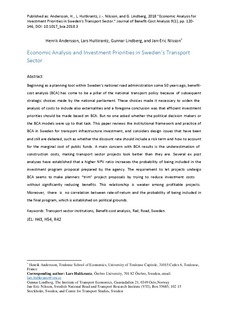| dc.contributor.author | Andersson, Henrik | |
| dc.contributor.author | Hultkrantz, Lars | |
| dc.contributor.author | Lindberg, Gunnar | |
| dc.contributor.author | Nilsson, Jan-Eric | |
| dc.coverage.spatial | Sweden | nb_NO |
| dc.date.accessioned | 2019-12-18T12:54:56Z | |
| dc.date.available | 2019-12-18T12:54:56Z | |
| dc.date.created | 2018-05-25T15:11:47Z | |
| dc.date.issued | 2018-03-22 | |
| dc.identifier.citation | Journal of Benefit-Cost Analysis. 2018, 9 (1), 120-146. | nb_NO |
| dc.identifier.issn | 2194-5888 | |
| dc.identifier.uri | http://hdl.handle.net/11250/2633953 | |
| dc.description.abstract | Beginning as a planning tool within Sweden’s national road administration some 50 years ago, benefit-cost analysis (BCA) has come to be a pillar of the national transport policy because of subsequent strategic choices made by the national parliament. These choices made it necessary to widen the analysis of costs to include also externalities and a foregone conclusion was that efficient investment priorities should be made based on BCA. But no one asked whether the political decision makers or the BCA models were up to that task. This paper reviews the institutional framework and practice of BCA in Sweden for transport infrastructure investment, and considers design issues that have been and still are debated, such as whether the discount rate should include a risk term and how to account for the marginal cost of public funds. A main concern with BCA results is the underestimation of construction costs, making transport sector projects look better than they are. Several ex post analyses have established that a higher NPV ratio increases the probability of being included in the investment program proposal prepared by the agency. The requirement to let projects undergo BCA seems to make planners “trim” project proposals by trying to reduce investment costs without significantly reducing benefits. This relationship is weaker among profitable projects. Moreover, there is no correlation between rate of return and the probability of being included in the final program, which is established on political grounds. | nb_NO |
| dc.language.iso | eng | nb_NO |
| dc.publisher | Cambridge University Press | nb_NO |
| dc.rights | Attribution-NonCommercial-NoDerivatives 4.0 Internasjonal | * |
| dc.rights.uri | http://creativecommons.org/licenses/by-nc-nd/4.0/deed.no | * |
| dc.title | Economic Analysis and Investment Priorities in Sweden’s Transport Sector | nb_NO |
| dc.type | Journal article | nb_NO |
| dc.type | Peer reviewed | nb_NO |
| dc.rights.holder | © Society for Benefit-Cost Analysis 2018 | nb_NO |
| dc.description.version | acceptedVersion | nb_NO |
| cristin.unitcode | 7482,0,0,0 | |
| cristin.unitname | Transportøkonomisk institutt | |
| cristin.ispublished | true | |
| cristin.fulltext | postprint | |
| cristin.qualitycode | 1 | |
| dc.identifier.doi | 10.1017/bca.2018.3 | |
| dc.identifier.cristin | 1586776 | |
| dc.source.journal | Journal of Benefit-Cost Analysis | nb_NO |
| dc.source.volume | 9 | nb_NO |
| dc.source.issue | 1 | nb_NO |
| dc.source.pagenumber | 120-146 | nb_NO |

